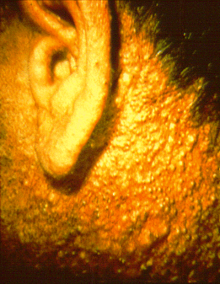| Chloracne | |
|---|---|
 | |
| Chloracne in this herbicide production worker involved almost every follicular orifice on his face and neck with comedones, papules and cystlike lesions. | |
| Specialty | Dermatology |
Chloracne is an acneiform eruption of blackheads, cysts, and pustules associated with exposure to certain halogenated aromatic compounds, such as chlorinated dioxins and dibenzofurans.[1] The lesions are most frequently found on the cheeks, behind the ears, in the armpits and groin region.
The condition was first described in German industrial workers in 1897 by Siegfried Bettmann,[2] and was initially believed to be caused by exposure to chlorine (hence the name "chloracne"). It was only in the mid-1950s that chloracne was associated with aromatic hydrocarbons.[3] The substances that may cause chloracne are now collectively known as chloracnegens.
Chloracne is particularly linked to toxic exposure to dioxins (byproducts of many chemical processes, including the manufacture of herbicides such as Agent Orange)—so much so that it is considered a clinical sign of dioxin exposure. The severity and onset of chloracne may follow a typical asymptotic dose-response relationship curve.
- ^ Plewig, Gerd; Melnik, Bodo; Chen, WenChieh (2019). "9.4.3 Acne mimicking diseases". Plewig and Kligman ́s Acne and Rosacea. Switzerland: Springer. p. 306-307. ISBN 978-3-319-49273-5.
- ^ Siegfried Bettmann (1869–1939), University of Heidelberg
- ^ Williams DE, Wolfe WH, Lustik MB, et al. (1995). "An Epidemiologic Investigation of Health Effects in Air Force Personnel Following Exposure to Herbicides". p. 427. A313403. Archived from the original on 2012-02-10. Retrieved 2008-08-20.